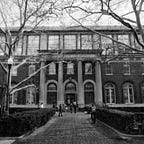Erick Gregory, LEED AP:
Chief Urban Designer + Director of the Urban Design Office
NYC Department of City Planning (GSAPP MSAUD ‘07)
Erick Gregory currently serves as Chief Urban Designer at the NYC Department of City Planning. Prior to his work in the public realm, he also worked in the private sector as an architect.
Mr. Gregory is both an architect and an urban planner by training. He holds a Bachelor of Architecture from the University of Oklahoma, and a Master of Architecture and Urban Design from Columbia’s Graduate School of Architecture, Planning and Preservation (GSAPP).
How did you get to where you are now? Did you have any major career transitions? How did your time at GSAPP set the foundations for your career path?
My background is in architecture and urban design. I received my Bachelor of Architecture from the University of Oklahoma and I worked in the field of architecture for a few years in California, after getting my Bachelor’s degree. I always felt I wanted to do something slightly different than just architecture, more broadly concerning neighborhoods and cities in general. So, I went to graduate school at Columbia and received a Master of Science in Architecture and Urban Design. When I finished in 2007, there were some jobs in Urban Design, but not many as this was right before the Great Recession in 2008. I wanted more project-based knowledge as an architect, so I went back into architecture for a couple of years and worked primarily on smaller-scale projects.
Then, an opportunity came up Department of City Planning in 2011. There was a transportation improvement grant (TIGER grant) that the city received to look at the Sheridan Expressway in the South Bronx. This created an opening for an urban designer, and I was hired for it. It matched what I learned in school, and one of my colleagues from City Planning also acted as a referral. This started my work in the public sector.
Would you say that there are any major differences between working for the public and private sectors?
There are differences, from both a personal and professional standpoint. On a personal level, there is a better work-life balance in the public sector. Respect for work-life balance varies depending on the company in the private sector. However, I have noticed that there is a tendency to work long hours in the architectural profession as a whole. This mentality has persisted to this day, and I do believe that the profession needs to change.
In the private sector, there is more freedom and more of an ability to push for things. In the public sector, however, there are more rules and regulations built into place. As a result, there is sometimes a need to bring in external consultants.
In the private sector, there is a bit more freedom to explore and innovate. This can be challenging working in government which must follow certain rules and regulations. The work in the public sector can sometimes be reactionary, but its strengths are rooted in and connected to the larger picture. The creativity lies not in the final product but through forming and laying the groundwork for others to innovate within.
The main upside to working for the government is the ability to push for change for your neighborhood and your city. For me, working for the City of New York is something I have always strived to do, so that I could bring positive change to my neighborhood and to this city.
How would you say that your education at GSAPP has set the foundations for your career?
The Urban Design program at GSAPP was a fast-paced, three-semester program. Before attending it, I thought I knew what Urban Design was through things I had read. However, my time at school definitely “awakened” me. One aspect was thinking about the larger picture of a building, beyond the immediate surroundings. What is the relationship of the neighborhood and city to that building and vice versa.
Columbia also taught me to present effectively. It taught me how to sell myself to an audience and how to construct an argument, and how to summarize and find the key points to share with others. In terms of preparing for a life in the professional arena, this was very important.
COVID-19 has had a devastating effect on the economy in general, including architecture. What are your suggestions for students and recent graduates who have been impacted by the virus?
It is certainly a difficult time for recent graduates to enter into the field. On the bright side, technology has made it much easier to search for jobs. The city offers some urban fellow programs to allow student and recent graduates to explore opportunities in civil service. There are also opportunities for planners and designers to work in many city agencies, like Mayor’s Office for Criminal Justice, NYC Housing Authority or the Economic Development Corporation, among others.
It is always hard to move from school to working full time. When I graduated, there were few jobs, and I took a job that I did not envision myself doing. Don’t be discouraged if opportunities are limited. There is a lot to learn from any work experience. At my first job, for instance, it was not glamorous work: I was working on chain restaurants. However, I did learn how to be a project manager and how to work in an office environment. I learned how to do many day-to-day things not taught in school.
It is also good to keep an eye out for good mentors. Having a good mentor is huge for any young professional, even if a job may not be exactly the way you imagined.
